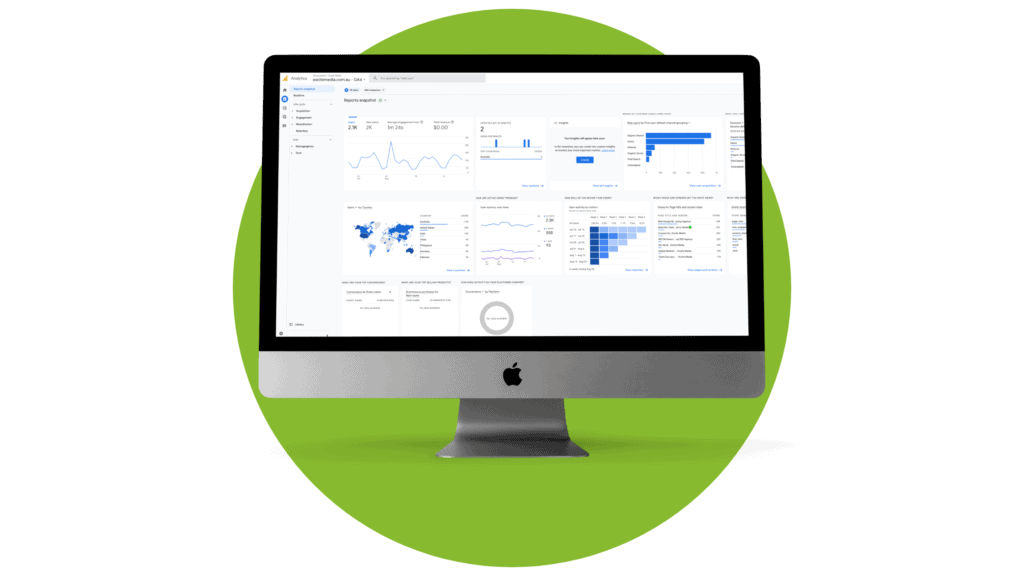Google Analytics’ newest version, GA4 – Google Analytics 4, is completely phasing out the previous ‘UA – Universal Analytics version within the next 12 months.
As of the 1st of July 2023 Universal Analytics (UA) will stop tracking data completely. Six months later, all of the data on Universal Analytics will be deleted.
So why the switch? And what is different about GA4? Read on, dear reader. We’ve got you covered.
And, if you’d like to know what you should do about it now and why jumping on GA4 before UA is completely phased out is important, be sure to check out our guide: You should switch to Google Analytics GA4 Today. And here’s why.

Table of Contents
ToggleSo, why has Google made the switch to GA4?
Universal Analytics was built for a specific purpose, at a specific time. It’s had add-ons and upgrades over the years, but at a certain point, you can’t keep adding new technologies – the structure just isn’t able to do what today’s digital world requires.
UA was built in a time that was very different to today’s digital world. As the then-new version of Analytics in 2012, it replaced its predecessor Urchin, which was around back in 2005. But in the world of the internet, 10 years is a long time.
It feels like so long ago now that everyone had hit counters on their website – and a refresh put that hit up by 1. At the time there were no smartphones, no apps, and no interconnected smart devices such as fridges and home entertainment systems being connected to the internet. Obviously a lot has changed. As technology and how we use it in our everyday lives change rapidly over time, so should the tools that we use to guide our marketing and business decisions.
A large part of the most recent changes in today’s digital world are the data privacy laws. With general privacy concerns, the highly publicised issues with data security and social media and the GDPR, the requirements for website tracking has changed significantly.
Universal Analytics is losing its effectiveness because people are installing ad-blockers on their browsers, there are browsers built with privacy as a priority, privacy laws are in place, and internet users are going out of their way to protect their privacy. People don’t want to be tracked. And they don’t necessarily want to be remarketed to. Remarketing still has its value. But other tactics are needed in addition.

What are the differences between Universal Analytics and GA4? 🔍
In a nutshell, everything is different. 🌰
GA4 was built for today’s online environment 🖥
It’s not too far of a stretch to assume that the days of mass tracking and gathering of data are soon to come to a close. Users don’t want to be measured, laws already in place in some countries are making it hard to measure, and others may soon follow. The technology is likely to make it harder to track data (in order to comply themselves and thus avoid massive fines and public lawsuits), and so there will likely be less of it.
There already is less volume of data. We may just not necessarily notice it. We see a dip in ‘visitors’ and actions taken online. But what is actually reduced is the visibility of this. Universal Analytics is missing data from those who do not want to be tracked. Untrackable data means insights are lost.
GA4 was built with machine learning and AI at its core, using this to glean insights in a digital world where not everything that we could measure before will be measured. Where before we relied on the volume of data to come through, the AI and machine learning of GA4 takes the amount of data that we can have and uses it for modelling, detecting trends and patterns and turning these into actionable insights. Facebook has already made a similar switch to modelling.
How does modelling work? Modelling is like a survey, where a sample of the population is measured, and the insights from this sample are used to detect patterns and statistically relevant information.

Some of the core differences between UA and GA4
Bounce rate 🏀
Bounce rate in Universal Analytics is an inaccurate measure of your users’ engagement.
Say you have a news website, or are publishing some fantastic blog content on your social media. A user can be highly engaged, read the whole article, spend 20 minutes on your site, have all of their questions answered, and then leave your website without clicking onto another page – resulting in that visit being counted as a ‘bounce’.
For one-page websites, bounce rates are also highly inaccurate in measuring engagement; the purpose of a one-page site being to tell the consumer everything they need to know there and then.
Even the move to longer content pages and minimal navigation required impacts bounce rate. The growing user habits of scrolling through news feeds, and the resulting expectation to have the same experience on a landing page or home page, is not supported by the bounce rate metric.
Additionally, of course, a user could be so engaged in the content on one page that they actually convert – but offline in an unmeasurable way – calling your phone number directly, or visiting on another device to convert. Or, even on the same device but after clearing their cookies. In both these cases, Google would report a bounce in Universal Analytics – deeming that first session as being ineffective and the user unengaged – a bounce. Where in reality that was a purchase-deciding session.
Bounce rate isn’t a thing in GA4. What has taken its place are engagement metrics; how many seconds the visitor is on your page, engagement events such as clicks, and the depth that they scroll – with defaults in the base tracking that are adjustable based on what you want to see.
Traffic volume 🚦
While UA focused on page views – volume – GA4 focuses on the engagement of those users.
If you notice ‘less traffic’ than before in your GA4 reporting, don’t be alarmed. It is likely the fact that (unfortunately, for those wanting to be as informed as possible about all the stats) we are getting less visibility into internet users’ movements, in order to protect privacy of users, complying with the laws and etcetera.
This is just the way of the future. Google’s machine learning and AI combats this in GA4 by looking at the purpose of the data and what we actually want to know: how to optimise our websites for more engagement and more sales. The machine learning helps us see better insights and turn this into real action. The new reporting features seem to do a great job of doing just this.
And to be completely honest, when there are bots, spammers, and irrelevant traffic hitting websites, the volume of website visitors becomes less and less important. Traffic volume doesn’t tell you how many relevant, engaged and high-value users visited your website. That comes with deeper analysis.
It’s the quality of that traffic, the relevance of your content and the way they engage with the site that is of the most importance when we look at traffic.
Because really, it does not matter how many unqualified users visited your website. What matters is the quality traffic that visited your site, and how engaged they were. Did your website answer their questions? Solve their problems? Provide value?
These are the things that will reflect in your tangible business results. And these are the things that we should focus on over ‘vanity metrics’ of the volume of website visitors.
Reporting with GA4 📈
Accessing the reporting in GA4 is very different to Universal Analytics. In fact, it can be quite challenging to get to your data.
Our digital experts at Excite Media are able to get you set up with GA4, including the basic setup and tracking as well as the deeper diving reporting and metrics. We can also help you with the reporting side of things – including learning how to interpret and make sense of the new reporting.
In the future, the reporting in GA4 may become easier to access and interpret. But in the meantime, it does seem that a large portion of Google’s effort has been in getting the new system’s operation and compliance with data laws – sorted first.
We’ll be sure to keep you updated on when this changes – but in the meantime, we make it easy for you to see your results too.
Excite Media clients and GA4 reporting 🤝
If you’re a client at Excite Media, we have you sorted. We get you set up for tracking everything you need to, and then we bring that data into third-party reports that are easy for you to see and understand.
We connect the raw data from your GA4 report and bring it into our reporting software, making it easy for you to see how your website is performing. These reports are the way to go while GA4 is being tweaked by Google to be more user-friendly and understandable to the user that’s not as tech-savvy in the behind-the-scenes.

The exciting new benefits of GA4: engagement focus
GA4 gives you more engagement metrics by default. External clicks, embedded video plays, and page scrolls to 90% are all default metrics that are tracked by GA4. These are engagement-focused.
GA4 makes it much easier to get these basic engagement metrics – with setting up other trackable events an option that takes time to set up, but gives you insight into where your site engagement can be improved.
That’s not all 🥁
It’s important to say that this is not a comprehensive list of the differences. But they’re some of the key differences for you to know.
The thing about GA4 is that it’s pretty advanced in terms of accessing, setting up and reading the reporting features. It takes even advanced reporting and technical experts a while to get their heads around the differences – in the ways we set up the more advanced tracking features, to the ways we access, read and interpret the reporting features.


Get help from our GA4 integration experts 👋
Our technical and reporting experts at Excite Media have been spending extensive time to get across all of the in-depth and advanced features and elements of GA4.
Our experts can save you the time and headache of trying to decipher all of the relevant information and what it means to you – including what you actually have to do about it. We can talk you through all of the relevant elements to your business when the time comes.
And of course, if you have questions about GA4 in the meantime, get in touch with our friendly team today.



